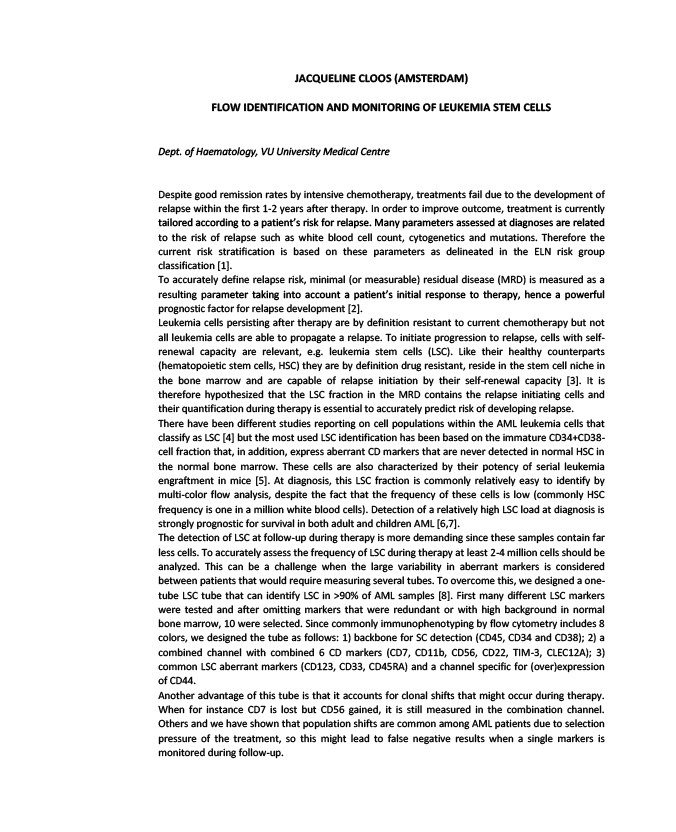
JACQUELINE CLOOS (AMSTERDAM)
FLOW IDENTIFICATION AND MONITORING OF LEUKEMIA STEM CELLS
Dept. of Haematology, VU University Medical Centre
Despite good remission rates by intensive chemotherapy, treatments fail due to the development of
relapse within the first 1-2 years after therapy. In order to improve outcome, treatment is currently
tailored according to a patient’s risk for relapse. Many parameters assessed at diagnoses are related
to the risk of relapse such as white blood cell count, cytogenetics and mutations. Therefore the
current risk stratification is based on these parameters as delineated in the ELN risk group
classification 1.
To accurately define relapse risk, minimal (or measurable) residual disease (MRD) is measured as a
resulting parameter taking into account a patient’s initial response to therapy, hence a powerful
prognostic factor for relapse development 2.
Leukemia cells persisting after therapy are by definition resistant to current chemotherapy but not
all leukemia cells are able to propagate a relapse. To initiate progression to relapse, cells with self-renewal
capacity are relevant, e.g. leukemia stem cells (LSC). Like their healthy counterparts
(hematopoietic stem cells, HSC) they are by definition drug resistant, reside in the stem cell niche in
the bone marrow and are capable of relapse initiation by their self-renewal capacity 3. It is
therefore hypothesized that the LSC fraction in the MRD contains the relapse initiating cells and
their quantification during therapy is essential to accurately predict risk of developing relapse.
There have been different studies reporting on cell populations within the AML leukemia cells that
classify as LSC 4 but the most used LSC identification has been based on the immature CD34+CD38-
cell fraction that, in addition, express aberrant CD markers that are never detected in normal HSC in
the normal bone marrow. These cells are also characterized by their potency of serial leukemia
engraftment in mice 5. At diagnosis, this LSC fraction is commonly relatively easy to identify by
multi-color flow analysis, despite the fact that the frequency of these cells is low (commonly HSC
frequency is one in a million white blood cells). Detection of a relatively high LSC load at diagnosis is
strongly prognostic for survival in both adult and children AML 6,7.
The detection of LSC at follow-up during therapy is more demanding since these samples contain far
less cells. To accurately assess the frequency of LSC during therapy at least 2-4 million cells should be
analyzed. This can be a challenge when the large variability in aberrant markers is considered
between patients that would require measuring several tubes. To overcome this, we designed a one-tube
LSC tube that can identify LSC in >90% of AML samples 8. First many different LSC markers
were tested and after omitting markers that were redundant or with high background in normal
bone marrow, 10 were selected. Since commonly immunophenotyping by flow cytometry includes 8
colors, we designed the tube as follows: 1) backbone for SC detection (CD45, CD34 and CD38); 2) a
combined channel with combined 6 CD markers (CD7, CD11b, CD56, CD22, TIM-3, CLEC12A); 3)
common LSC aberrant markers (CD123, CD33, CD45RA) and a channel specific for (over)expression
of CD44.
Another advantage of this tube is that it accounts for clonal shifts that might occur during therapy.
When for instance CD7 is lost but CD56 gained, it is still measured in the combination channel.
Others and we have shown that population shifts are common among AML patients due to selection
pressure of the treatment, so this might lead to false negative results when a single markers is
monitored during follow-up.